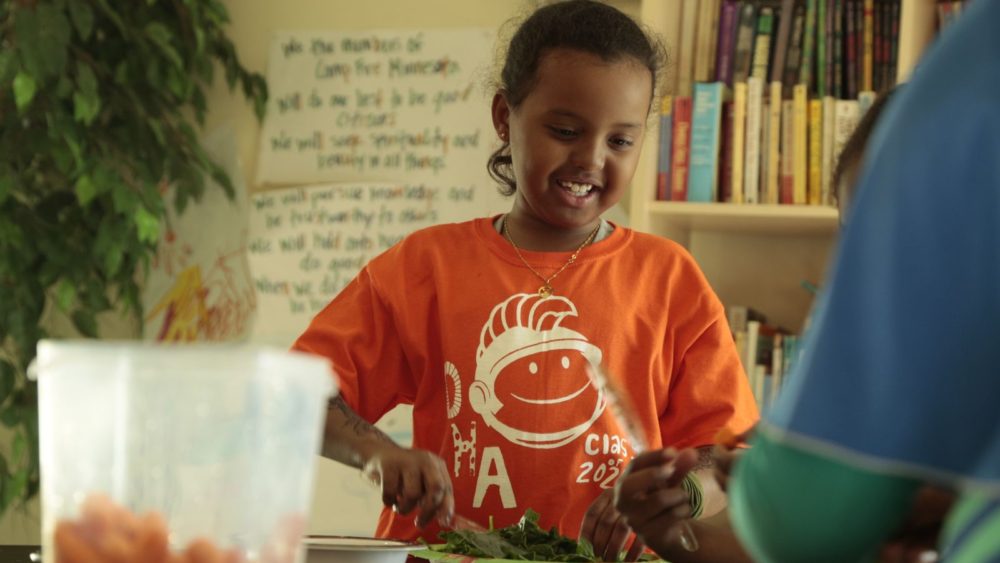 |
For the students and staff of Camp Fire Wise Kids® afterschool programs in and around Dallas, Texas, health is all about balance. By emphasizing the importance of a balanced diet and of balancing “energy in” and “energy out,” staff hope to empower children to make a lifetime’s worth of healthy and wise choices.
Like other Camp Fire programs across the nation, the Wise Kids program relies on the “Thrive{ology}” framework. Described as a “research-based, measurable approach to youth development,” Camp Fire developed the approach in partnership with the California-based Thrive Foundation for Youth. It comprises four components:
- Helping children identify their “sparks” – that is, their interests and passions
- Guiding them to adopt a “growth” mindset – the belief that they can learn new skills all the time
- Urging them to set and manage goals for themselves
- Encouraging them to reflect on what they’ve done and accomplished
Camp Fire Lone Star layers its Wise Kids framework over the health and physical education standards written into the Texas Essential Knowledge and Skills (TEKS) standards issued by the state’s department of education. The health and physical education standards are generally in line with the Healthy Eating and Physical Activity (HEPA) standards developed by the National AfterSchool Association.
“We’ve incorporated Thrive{ology} into everything we do,” says Sheri Hemby, program executive at Camp Fire Lone Star. “Kids face so many challenges nowadays – emotional and physical, expectations they perceive from the media, and so on. It’s a lot to take on. In terms of health and wellness, we try to give them tools to keep things in balance,” so they see the link between what they eat and the energy they expend in exercise.
“I also like the way we talk about what healthy looks like,” she continues. “Kids see what the media puts forward; they see what is held up as the ‘ideal body’ type. And while there have been a lot of changes in this area recently, the incidence of eating disorders and emotional disorders related to body image is not decreasing. So getting past what the media tells them about a healthy body image is really important.”
She says that during group activities, adult leaders guide conversations with their students about body image, health, and balance, creating opportunities for students to connect taking care of their body’s needs with feeling good and being able to set, accomplish, and reflect on goals.
As part of these conversations, adult leaders emphasize balance so that students can learn to disassociate having an occasional unhealthy snack with having an unhealthy lifestyle. Hemby emphasizes the importance of helping children understand the traps that such media-driven associations can create.
“You want kids to know that super skinny may not be super healthy. You can carry a little more weight and be extremely healthy and very strong. We want them to learn that and accept their bodies, communicating to them that being healthy is about feeling good and being strong enough to find their spark, set goals and attain them, and to reflect back on things, so they can do the things they dream about doing.”
The program uses a “learn, do, play” model to impart its lessons to more than 1,000 students. During the first 15 minutes of an hour-long session, students begin to learn new concepts through conversations and workbooks that introduce key concepts and self-directed activities. Students use the next 15 minutes to do a group activity related to the topic, such as matching food groups with particular foods; this exercise is intended to allow children to find a “voice” and express concepts in their own vocabulary. The last 30 minutes is given over to play, engaging in physical activities that incorporate the day’s topic, such as a relay race combined with a science experiment.
Staff take that same approach to lessons on a variety of health topics, including the importance of water to the body and how to gauge a serving size for a particular food. Hemby notes that because the learn, do, play model encourages students to discuss topics in ways that are meaningful to them, she has seen students share lessons with their peers in the lunchroom by, for example, comparing a serving size to an everyday object.
More than 80 percent of the students Camp Fire Wise Kids serves are eligible for free and reduced-price lunches, but Hemby says the program is vital to students in all demographics.
“It’s about helping children develop a ‘growth’ mindset. Regardless of how wealthy their families are, important that children learn to advocate for themselves and take ownership of their health. Some children might not have had the information or the tools they need to develop those skills before they reach us, and others might have all the resources they need but not a reason to own their health because their parents have made all their choices. We want all our kids to be able to make good decisions about their health, regardless of their backgrounds.”

Comments are closed.